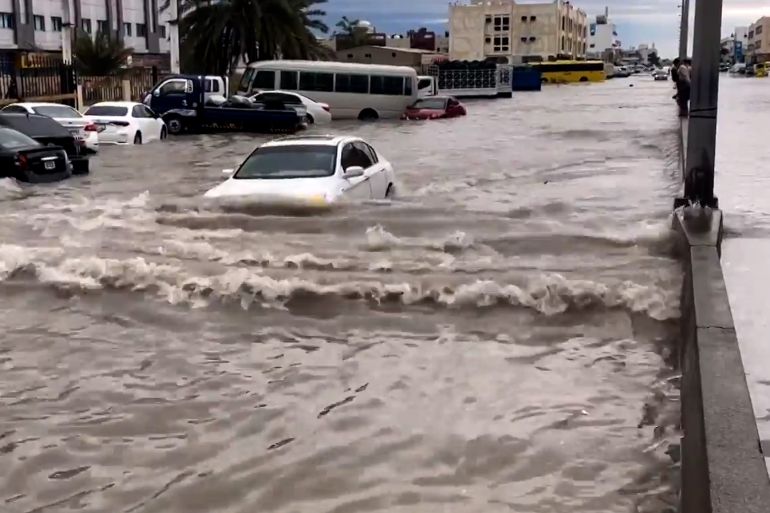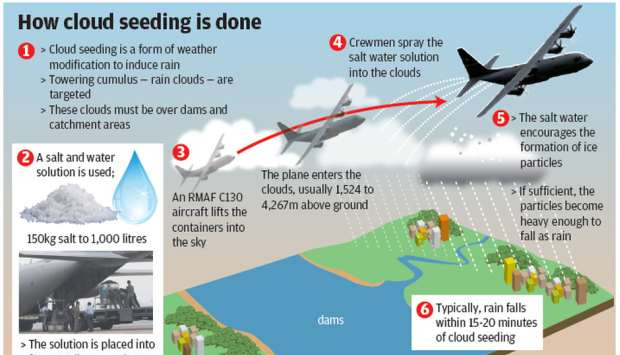What is cloud seeding and did it cause the floods in Dubai?
Written by Sneh Chaudhry on April 18, 2024
Cloud seeding almost certainly did not play a significant role in the flooding on the Arabian peninsula this week – but the heavy rains may have been exacerbated by climate change.

Record rainfall hit the Arabian peninsula this week, causing flooding in Dubai and Abu Dhabi, as well as other coastal cities in the United Arab Emirates. The extreme weather prompted speculation on social media about whether the UAE’s longstanding cloud-seeding programme played a role.

But cloud seeding almost certainly didn’t have any significant hand in the flooding.
How unusual was the recent rain in the Arabian peninsula?
In the UAE, it was the most extreme such event since records began in 1949, according to the state-run Emirates News Agency. Between 15 and 16 April, several parts of the country saw more rain in 24 hours than normally falls in an entire year. Heavy rains are unusual for the desert region, although not unheard of – the UAE saw heavy rain and flooding in 2016, for instance.

Drainage systems in the UAE’s coastal cities were overwhelmed by runoff, which led to flooding. Dramatic images of planes taxiing through standing water at the Dubai International Airport were shared widely online.

In the neighbouring country of Oman, flash floods killed at least 18 people. Bahrain, Qatar and part of Saudi Arabia also saw unusual rain.
What is cloud seeding and did it play a role in the extreme rain?
Cloud seeding is a method of increasing precipitation that has been around since the 1940s. It involves spraying a powder, such as silver iodide, into clouds from planes or rockets, or by burning them from ground-based stations. Droplets of supercooled water can form around these particles, which then fall to the ground as rain or snow.
The UAE has maintained one of the world’s most extensive cloud seeding programmes since 2002. To increase freshwater resources in the arid region, planes regularly fly cloud-seeding missions.

Speculation that cloud seeding may have played a role in the recent rain was fuelled after a meteorologist from the UAE’s National Centre of Meteorology (NCM) told Bloomberg News that planes had seeded clouds above the country in the days before the storm. However, the NCM later said in a statement that no seeding had taken place during the storm.
“We take the safety of our people, pilots and aircraft very seriously,” it said. “NCM doesn’t conduct cloud seeding operations during extreme weather events.”
Even if cloud seeding had taken place during the storm, it would have had at most only a marginal effect on the amount of precipitation, and only in local areas. The extent of the rain across several countries, and the limited impact of cloud seeding in general, suggests it almost certainly played no significant role. “There is no technology in existence that can create or even severely modify this kind of rainfall event,” said Maarten Ambaum at the University of Reading in the UK in a statement.
He pointed out that cloud seeding would have little effect on clouds that forecasts had already predicted would dump rain on the region. And that is assuming cloud seeding is effective at all.

“Many of the claims of successful cloud seeding are wrong, scientifically flawed or actual fraud,” says Andrew Dessler at Texas A&M University. “This makes most atmospheric scientists very sceptical of cloud seeding.”
What meteorological factors were behind the rain?
The extreme precipitation was driven by a large storm called a mesoscale convective system. Suzanne Gray at the University of Reading says this occurs “when lots of individual thunderstorms amalgamate to form a single, large high-level cloud shield”.

Forecasters were projecting a high risk of flooding in the region at least a week ahead of the storm. Writing on X, Jeff Berardelli, a meteorologist at WFLA-TV in Florida, linked the storm to a blocking pattern created by a slow-moving jet stream.








